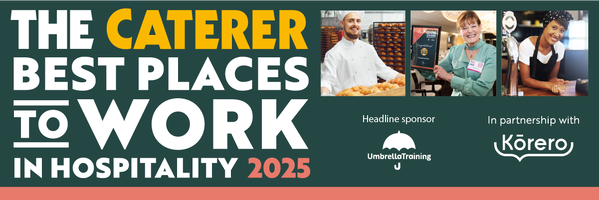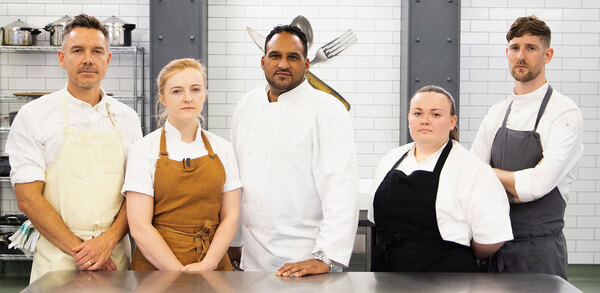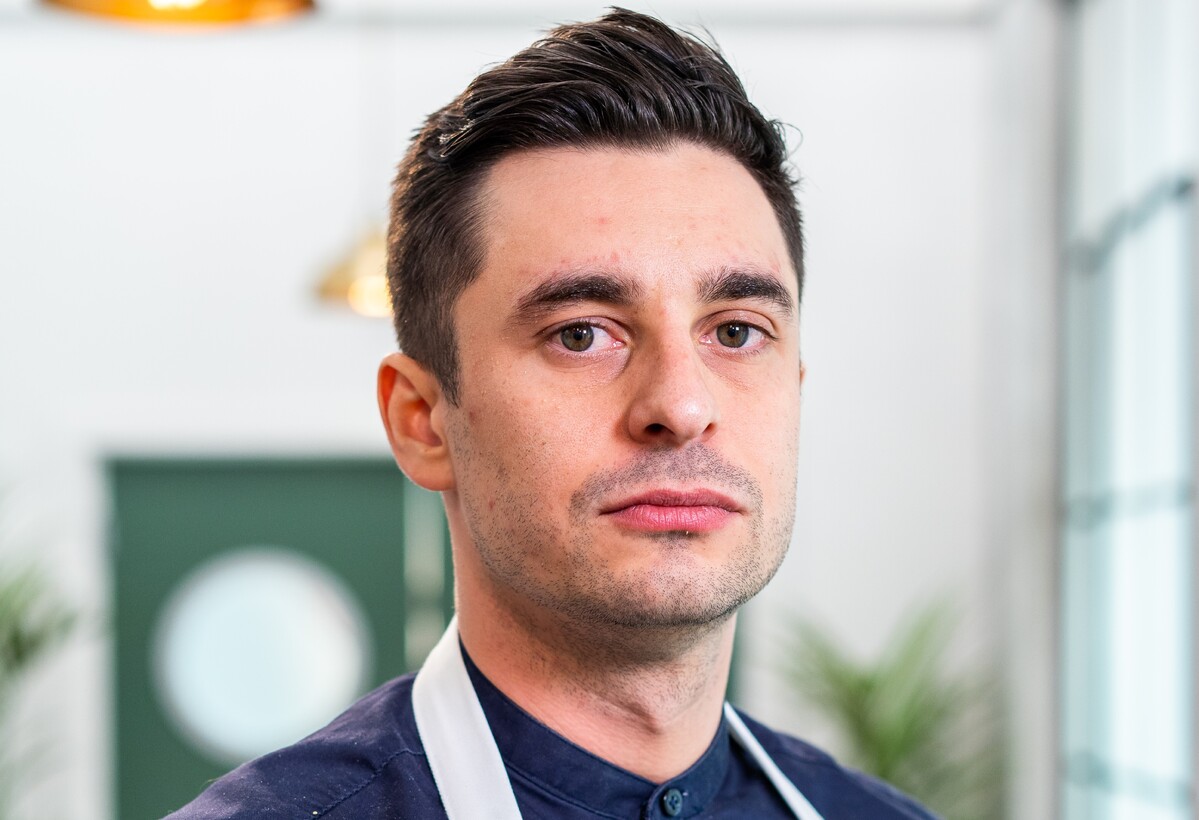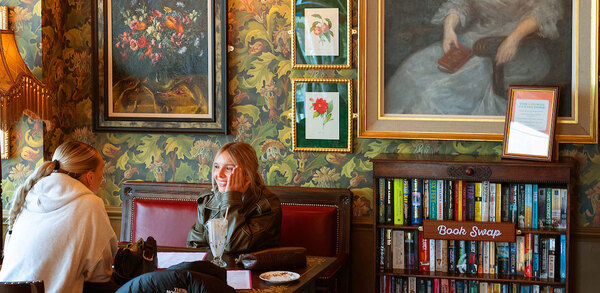Nigel Platts-Martin: The quiet man?
igel Platts-Martin is something of an enigma. He is one of London's most successful and influential restaurateurs, the winner of the 2004 Catey for Independent Restaurateur, and co-owner of five award-winning restaurants, including the Square and Chez Bruce. His businesses have total annual sales of £13.2m, employ 220 people and serve about 190,000 customers a year. Yet his name is barely known outside the industry. So how did a former City lawyer and banker with no industry experience come to run a group of restaurants with five Michelin stars between them? And what is the secret of his success?
In his chinos, sports jacket and steel-framed glasses, the slightly built 51-year-old is the epitome of the modern successful businessman. He has come prepared for our meeting at the newly refurbished Square in Mayfair with notes and piles of paperwork that he checks names and dates against as we talk. So it's something of a leap to imagine this serious, considered man arm-wrestling Marco Pierre White in the early hours of the morning after dinner at Lampwick's, a now long-forgotten restaurant in Battersea where White was working back in 1986.
"We were very competitive but Marco always won," recalls Platts-Martin with a rueful smile. "He didn't do anything unless he knew he would win. We started eating out together and soon became friends with a shared interest in food."
Platts-Martin had caught the restaurant bug during holidays in France in the early 1980s. "It was the height of nouvelle cuisine and I ate at many great restaurants, such as L'Esperance, Boyer and Georges Blanc. They made a huge impression on me. I collected all the menus and wherever possible I got them signed," he recalls. "I asked for the labels to be removed from the wine bottles and I came back and made collages of them and framed them all. I was terribly nerdy about it."
In 1986 Platts-Martin decided to draw a line under a career in the City that began in 1976 with top City lawyers Freshfields (he studied law at Oxford) and ended when he left the corporate finance department of Warburg's. "I wasn't sure what I wanted to do but it was certainly something more creative than banking." He claims there was no grand plan when he decided to buy what was a failing brasserie opposite Wandsworth Common known as Harvey's. "It was in a terrible state but I bought it out of youthful optimism and invited Marco to become head chef. I knew Marco was an extremely talented chef who cooked sensational food but I was very unsure how things would turn out."
Harvey's opened in January 1987 and got the London restaurant wags talking from the word go. Within 12 months the restaurant had its first Michelin star and won its second after just three years. "It was a seminal restaurant and that was down to one man and that was Marco."
Modest profits
Despite an enviable reputation, Harvey's turned out to be financially relatively disappointing. "It made modest profits over the six years but today Chez Bruce turns over more than three times what Harvey's did in its best year. And we run a much tighter ship."
Marco's ambition led him to look in other directions to further his burgeoning career. "He had outgrown Harvey's and we bought him out in 1993. But it was his choice to make the break."
When Platts-Martin bought the Square in 1991 - recruiting ex-Harvey's chef Philip Howard to head up the kitchen - his attitude to the restaurant business changed. "It became my livelihood and that concentrated the mind wonderfully. I had to learn the nuts and bolts of the restaurant business. I even manned the reception desk for a year or so which helped me to understand where our business came from."
The restaurant opened in January 1992 with the economic recession in full swing following the fist Gulf War. "Market conditions were extremely tough and sales were very hard to come by. We lost a lot of money in the first year but we were able to turn it around pretty quickly," Platts-Martin explains.
He took a hands-on approach to increasing sales by identifying the restaurant's natural sources of business and exploiting them. "Trade revolved around the business, theatre and hotel communities and I was very proactive in developing those relationships. I did a promotion with the Theatre Royal Haymarket and a similar one with the Coliseum. I also got to know all the local hotel concierges personally. I had to fill the place up to survive."
Platts-Martin is quick to acknowledge Philip Howard's contribution to achieving that goal. "He played a vital role in developing the reputation of the Square," he says, pointing to the Michelin star won in 1994 and a second in 1998. For his part, Howard's perspective of Platts-Martin confirms the latter's chief assets as a restaurateur - attention to detail and business focus. "Nigel is a relentless perfectionist who is able to maintain a clear vision of what we are trying to achieve and how and with whom we should achieve it," Howard says.
The Square may have been a new project for Platts-Martin, but he also redeveloped the Harvey's site, asking chef Bruce Poole to join him as a partner in the business in 1994 and renaming it Chez Bruce. Thus, the current structure of his business empire was set in place; two restaurant businesses in parallel - the Square and its younger sibling the Ledbury with Howard; and Chez Bruce, the Glasshouse, in Kew, and Chiswick's La Trompette with Poole.
These days Platts-Martin's role is less operational and more centralised. It's surprising to learn that despite the size of the company, there is no head office and Platts-Martin works from home. Much of his time has been spent finding, purchasing and subsequently developing the five restaurants. In retrospect, it may look as if his pathway to success has been seamless, but appearances are deceptive. In fact, many of his restaurant purchases were problematic and would have deterred other buyers.
"The Harvey's lease was subject to a forfeiture notice because of dilapidations and the Square's original King Street location was in receivership when it came up for sale.
The planning permission for the Ledbury contained an unworkable condition that prevented the kitchen extraction from operating before 11.00am and there was an outstanding rent review which had gone to arbitration. In all it took 18 months to purchase the Ledbury, get all the necessary consents to redevelop it, fit it out and get the place open."
Although Platts-Martin is careful not to underplay getting the site right in terms of location and physical space and design, the choice of chef, he says, is key. Brett Graham of the Ledbury is the latest in a line of outstanding cooks that have emerged from the various restaurant kitchens: Graham was Howard's sous chef at the Square, Howard was from Harvey's, Poole from the original Square, Anthony Boyd of the Glasshouse from Chez Bruce and the Square, and James Bennington of La Trompette from Chez Bruce. But "talent spotter" is not a term he's comfortable with.
"If I have an ability it's that I've managed to choose my partners well. Bruce, Phil and I work very closely together and seem to manage to get the best out of each other. Phil runs the busiest two-star restaurant in the country and Bruce has created one of London's most highly regarded and popular restaurants. I certainly couldn't have achieved what I have without them."
Professional
No one's going to argue with Platts-Martin's statement, but, like Howard, Poole pinpoints his partner's thoroughness as a vital ingredient of their combined success. "Nigel's a consummate professional," he confirms, before shedding a more personal light on Platts-Martin by adding: "There's no one I'd rather talk football with." With his precise appearance and controlled demeanour, football and Platts-Martin seem incongruous bedfellows.
Leaving football aside, Poole's analysis of Platts-Martin as a businessman is borne out by the facts. With 40 years of trading between the five restaurants, Platts-Martin's businesses have a proven track record of sustained success and, remarkably, the group's expansion has been financed solely from cash-flow rather than bank borrowings. Ironically, this consistency has also meant constant change.
"All our restaurants are very different today from when they started out. Good restaurants mature and good chefs improve. We've developed all the businesses slowly but surely over the years. Fine-tuning is a permanent feature of what we do." A system of detailed reporting from each restaurant feeds into that fine-tuning process. "The daily financial and operational reports are very, very important; they tell us how we're performing and most importantly what we've got to do to improve."
Wine is important to Platts-Martin's reputation as a restaurateur. All his places have award-winning wine lists and wine accounts for about 45% of total sales. Together, the five restaurants have £1.75m-worth of stock, a significant part of which is wines for future listing. "Once those wines mature, they give depth to our lists and enable us to offer rare wines at fair prices," he explains. "There are very few restaurants that operate in that way."
Although he attends many trade tastings, Platts-Martin leaves his sommeliers to compile their own lists. "We don't have a central buying policy so each list has its own identity, just as each kitchen has its own menu and identity. It's better all round if you employ sommeliers of ability and let them get on with it."
Platts-Martin doesn't often give interviews and usually prefers to let his businesses speak for themselves. Some might even call him as a bit of a recluse, a description he claims not to recognise. "It has been said about me from time to time. I'm amused by it more than anything else. I'm active on the wine circuit, I eat out a lot, I'm pretty accessible," he argues.
Surprisingly, although Platts-Martin's businesses are strongly associated with fine dining and Michelin stars, his personal tastes in restaurants are simpler. "My favourite cuisine is Italian and I love Italian wines. I tend to frequent restaurants where I can enjoy simply prepared food and a well-chosen and fairly priced bottle of wine. Enoteca Turi in Putney is a particular favourite."
And his advice to putative restaurateurs is equally as simple. "The key ingredient is to understand who your target customers are and what they want. As part of that you need to be clear about what you are trying to deliver to your customers in terms of your overall product - food, drink, service, design, ambiance and pricing. It's also crucial to maintain standards and continue to please your customers."
As for the future, don't expect news of another Platts-Martin venture too soon. "There's nothing planned but things can change. In the meantime we continue to improve what we do."
There's no doubting that Platts-Martin's passion and enthusiasm for the business remains undimmed. Our conversation exceeds the allotted morning appointment and never once strays from the subject of restaurants, food and wine. As I pack my notebooks and tape recorder away, outside the lunchtime trade begins to fill the restaurant. "Listen," he says. "The sound of contented customers - that's what it's all about!"
The restaurant
**Platts-Martin with Philip Howard…
The Square**
6-10 Bruton Place, London
020 7495 7100; www.squarerestaurant.com
Opened: 1992 in Kings Street, London. Relocated to Bruton Place in 1997.
Head chef: Philip Howard
Two Michelin stars
Signature dishes: herb-crusted saddle of lamb with shallot purée, artichokes, balsamic vinegar and olive oil.
Critics corner: "Beautifully judged cooking in the classic mould, full of subtle effects that contributed to the whole without drawing attention to themselves." Matthew Fort, the Guardian, 13 September 1997.
The Ledbury
127 Ledbury Road, Notting Hill
020 7792 9090; www.theledbury.com
Opened: 2005
Head chef: Brett Graham
One Michelin star
Signature dish: Loin of tuna wrapped in basil with a salad of radish and soy.
Critics corner: "The Ledbury, with its brilliant new chef, sets a new polished standard for Notting Hill and elsewhere." Jan Moir, Daily Telegraph, 14 May 2005.
Platts-Martin with Bruce Poole
Chez Bruce
2 Bellevue Road, London
020 8672 0114; www.chezbruce.co.uk
Opened: 1995
Head chefs: Bruce Poole and Matt Christmas
One Michelin star
Signature dishes: roast cod with olive oil mash and gremolata.
Critics corner: "Chez Bruce still stands for honest, unfussy, earthy, richly flavoured food. The menu boasts old-fashioned dishes that never pander to the latest gastro-trend." Charles Campion, London Restaurant Guide 2006.
The Glasshouse 14 Station Parade, Kew
020 8940 6777; www.glasshouserestaurant.co.uk
Opened: 1999
Head chef: Anthony Boyd
One Michelin star
Signature dish: Warm salad of wood pigeon with deep-fried truffled egg.
Critics corner: "The finest lunch in memory, at a restaurant of heartbreaking brilliance" Matthew Norman, Sunday Telegraph, 30 September 2003.
La Trompette
5-7 Devonshire Road, Chiswick, London
020 8747 1836; www.latrompette.co.uk
Opened: 2001
Head chef: James Bennington
Signature dish: Baked quail pithiviers with shallot purée and port sauce.
Critics corner: "Chiswick residents will be thrilled to have it in their midst." Fay Maschler, London's Evening Standard 14 May 2001.
Tips for the top Have you been inspired by Nigel Platts-Martin? Are you contemplating launching yourself as a restaurateur? Here are some tips:
- Restaurants are businesses and business expertise is essential. A passion for cooking is not enough.
- Be clear who your target customers are and what they want.
- Don't overspend on your premises and ensure the business is properly financed.
- Be on top of your cash-flow. Know your breakeven and the relationship between your costs and sales.
- Invest in your staff and train them. Happy, well-trained and motivated staff make for contented customers and repeat business.
The outside view
"Nigel's an individualist. He's a tricky old fusspot and that's what makes his restaurants great - he's got that eye for detail. He's very good at recognising and then investing in talent. He's also an incredibly good wine buyer."
Rowley Leigh, chef-proprietor Kensington Place
"In his obsessive, pernickety way, Nigel Platts-Martin has been as influential a presence on the London restaurant scene as much more flamboyant figures. He seems to have a happy knack of getting things absolutely spot on. Off hand, I can't think of a single duff Platts-Martin venture."
Matthew Fort, food editor, the Guardian
















